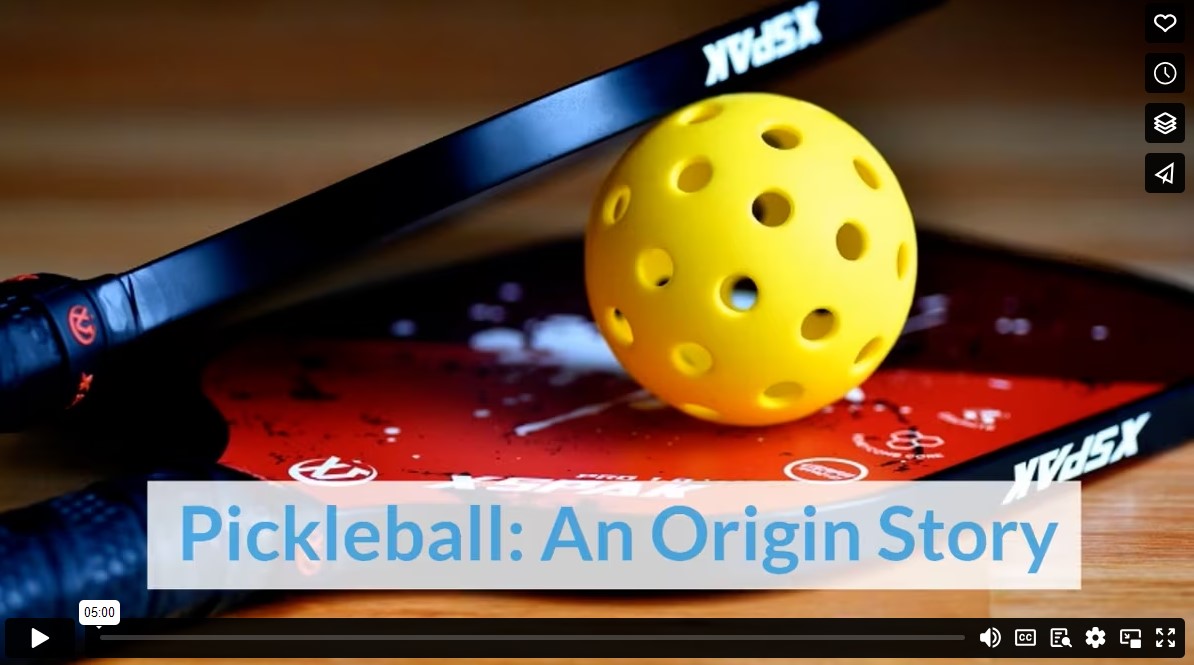“I’m booooored…” Every parent knows that particular whine. In the 1960s, two friends faced this very familiar situation – their families sitting around with nothing to do, or at least nothing they wanted to do. Their response? Inventing a sport based on equipment they had around their house. That’s how pickleball was born. Let’s examine the game’s history and how an afternoon of summer boredom became a beloved international pastime.
Boredom Buster
In 1965, Washington State resident Joel Pritchard, who would later go on to serve in the United States Congress and as Washington state’s lieutenant governor, and his friend, businessman Bill Bell, went to Pritchard’s home near Seattle, WA. They found their bored families sitting around, looking for something to do. Remembering the badminton court on the property, the men thought to engage the family in a match.
The only problem? They couldn’t find a set of rackets. Necessity being the mother of invention, they grabbed some table tennis paddles and the accompanying small plastic ball and hit the court. Initially, their play was very similar to badminton, trying to get the ping pong ball over the raised net. However, they quickly discovered that the small ball bounced when it hit the court’s surface. That inspired them to lower the net to sit just off the court’s surface, like a tennis net. The game was a hit.
The following weekend, Pritchard introduced his hybrid badminton/ping pong/tennis game to visiting friend Barney McCallum. Pritchard, Bell, and McCallum set about codifying the new game’s rules, focusing on creating an activity that would encourage family time and could be played by anyone, regardless of skill level or athletic ability.
Beyond the Backyard
Two years later, the first purpose-built pickleball court was constructed in the backyard of Pritchard’s neighbor, Bob O’Brian. Pickleball quickly gained popularity among friends and neighbors. In 1972, Pritchard, McCallum’s son David, and two other friends formed Pickle Ball, Inc. and trademarked the name “Pickle-Ball.” (The name of the sport has since dropped the hyphen: pickleball.) Their new company produced wooden pickleball paddles and other pickleball equipment to meet growing demand.
The National Observer wrote an article about pickleball in 1975. Another piece on the sport appeared in Tennis magazine the following year, bringing even more attention to America’s newest racket sport. With the growing popularity of the pastime, it was only natural that players would want to test their skills to see how they compared to other player’s abilities. The first pickleball tournament was held in 1976 in Tukwila, WA, at the South Center Athletic Club. Davis Lester won the Men’s Singles title. Because the sport was still so new and relatively unknown, the players used large wooden paddles and a softball-sized ball, rather than the smaller, official pickleball balls we know today.
Further interest in the game came from a 1978 book called The Other Racquet Sports by Richard “Dick” Squires, which included information on pickleball. Squires said, “Pickleball has all the appeals to become a national rage” and that if handled properly, “its success will be assured.” He was right, though it would be a few more decades before pickleball became a national and international phenomenon.
A few years after Squires’ book was published, avid racquetball player Sid Williams found the sport and began organizing tournaments. His pickleball competitions were often attended by Pritchard, who endorsed the tournaments and would sometimes present the awards to the winners. In 1984, the United States Amateur Pickleball Association, with Williams serving as executive director, published the first pickleball rule book. That helped standardize the sport, allowing it to become even more popular.
A 21st Century Game
While pickleball had many fans and supporters throughout the final decades of the 1900s, its popularity exploded in the 2000s.
In 2001, the Arizona Senior Olympics included pickleball, with more than 100 participants. That made it the largest pickleball event played up to that point. In 2005, the USA Pickleball Association (USAPA) was created. Three years later, their rules committee published an official rulebook. Shortly after that, the National Senior Games Association included pickleball in their list of official games, recognizing both the game’s popularity and a suitability to seniors’ fitness levels.
Good Morning America included a live segment on the game, which gave pickleball additional exposure to audiences who had never heard of it until they saw it featured on their favorite morning news program. At that point, pickleball had entered the mainstream. Almost 400 players from 26 US states and several Canadian provinces participated in the USAPA’s first national tournament in November 2009.
And the sport keeps growing in popularity. In 2010, pickleball was called the fastest-growing sport in the United States. And pickleball got an additional boost during the Covid-19 pandemic when people sought outdoor pastimes.
There are even professional pickleball teams, with one co-owned by basketball legend LeBron James.
The Rest is Pickleball History
That’s how a quiet summer afternoon in a future congressman’s backyard turned into a popular pastime and an immensely popular sport played by people of all ages and ability levels. Despite its humble beginnings, pickleball has been the fastest growing sport in the US for the past four years in a row, and we think 2023 will be another banner year for the sport. If you’ve never tried it, grab a pickleball racket, watch a few pickleball videos for beginners, and join with the over 36 million people in the United States who love playing pickleball.
Infographic
In the 1960s, friends Joel Pritchard and Bill Bell birthed pickleball to combat family boredom, using table tennis paddles and a plastic ball. The first official court, in Bob O’Brian’s backyard, led to Pickle Ball, Inc. Media attention, tournaments, and senior games recognition followed, propelling pickleball to the fastest-growing US sport. Boasting 36 million enthusiasts, its trajectory foresees continued growth in 2023. Explore the journey from boredom to a beloved international pastime with this infographic.

Video




